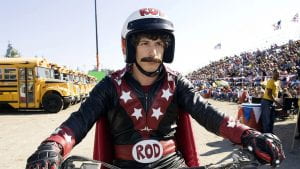Every month, Establishing Shot brings you a selection of films from our group of regular bloggers. Even though these films aren’t currently being screened at the IU Cinema, this series reflects the varied programming that can be found at the Cinema and demonstrates the eclectic tastes of the bloggers. Each contributor has picked one film that they saw this month that they couldn’t wait to share with others. Keep reading to find out what discoveries these cinephiles have made, as well as some of the old friends they’ve revisited.
Jack Miller, contributor | The Harvey Girls (1946)
George Sidney’s The Harvey Girls has always been considered a “second tier” MGM musical, perhaps because Sidney has never enjoyed the same high reputation as Vincente Minnelli, Stanley Donen, or even Charles Walters, to cite his three greatest running mates in the studio’s legendary Freed Unit. Yet, it could be argued that Sidney’s films do carry the distinctive stamp of an auteur: the raucous energy of The Harvey Girls seems to explode in many different directions, unabashed and uncontained. Whereas a Minnelli musical, for all its ambition and scope, can feel somewhat self-contained, always moving toward a pre-determined and gracefully executed climax, a Sidney title might indulge its own strange excesses in the name of pure pleasure. For a film that tells the story of the triumph of the “good time” over the “wild time” in the old west, Sidney & Co. sure do seem to be enjoying themselves when filming the wild side of things.
The Harvey Girls also unites the aesthetics of my two favorite genres, the musical and the western. It boasts one of the finest group performance numbers in classical Hollywood cinema: “On the Atchison, Topeka, and the Santa Fe,” which comes near the very beginning of the film, is completely magical, a triumph of studio resourcefulness. Apparently, Judy Garland nailed her performance in this number in just one take. To put it more succinctly, if you love intricate choreography, great songs, bold Technicolor, Judy Garland wielding two guns and a beefsteak, wild western brawls, or (as the film’s trailer puts it) “gay and lusty romance,” then The Harvey Girls might just be the gem for you!
Michaela Owens, Editor | Hot Rod (2007)
I’ve been a huge fan of the Lonely Island since their early days at Saturday Night Live, but it wasn’t until about four or five years ago that I finally caught up with their movies Hot Rod and Popstar: Never Stop Never Stopping. Although both didn’t do well at the box office in their initial releases, they’ve since found their audiences, who recognize the brilliance and beauty of the group’s specific brand of absurdity. While Popstar truly holds a special place in my heart, Hot Rod is like a marriage between what my comedic sensibility is now and what it was when I was ten and obsessed with Napoleon Dynamite.
A wannabe stuntman who spends his days goofing off with his crew, pining for the girl next door (Isla Fisher), and vowing to finally earn the respect of his prickly stepfather (Ian McShane), Rod Kimble (Andy Samberg) decides to attempt his biggest stunt yet: jump 15 buses and raise $50,000 for his stepfather’s heart transplant. Stuffed with relentless gags like Will Arnett repeatedly screaming “babe” at Isla Fisher — which actually encouraged me to watch this movie after I saw Edgar Wright rave about it — and Rod’s Footloose-inspired dance in the woods that ends with him falling down a hill for almost a full minute, Hot Rod is undoubtedly an odd comedy that won’t be for everyone, but it is absolutely for me thanks to its stellar cast (Bill Hader! Danny McBride! Sissy Spacek!), ridiculous humor, and weird little heart.
Jesse Pasternack, contributor | Women Talking (2022)
Women Talking is one of the best films of 2022. It boasts an excellent screenplay, richly cinematic filmmaking, and a brilliant cast. All of these elements help make it an incredible group portrait of characters whom you will never forget.
The film takes place in an unnamed, isolated religious colony in 2010. The women of the colony have discovered that the men of their community have been drugging and sexually assaulting them. One day, when the men leave to post bail after one of them is jailed, the women have a meeting on the second floor of the colony’s barn. They debate between three options of how to respond to the male attackers who live amongst them: do nothing, stay and fight, or leave. Intellectual Ona (Rooney Mara), fiery Salome (Claire Foy), and traditional Mariche (Jessie Buckley) argue as kind-hearted August (Ben Whishaw) takes the minutes of their meeting in part because of the lifelong love he has for Ona. In the end, the women come to an understanding and do what is best for them.
One of the strongest elements of Women Talking is its impeccable screenplay by writer-director Sarah Polley. She does a fantastic job at exploring her story’s rich themes and providing equal space for each of her complex female characters to express their own unique point-of-view. Polley particularly excels in the early scenes of Ona articulating what kind of community she wants the colony to become and the reactions of her fellow women to it. That scene, and the film as a whole, features some of the best dramatic writing related to politics I’ve seen in years.
That last paragraph may make this film sound excessively theatrical, which it is not. From the opening shot (an overhead angle of Ona sleeping), Polley demonstrates that she has a great knack for using cinematic language. Some examples include but are not limited to her use of camera movements which are fluid yet purposeful, shots of empty rooms with voiceover that enhances their meaning, and perfectly composed images. A long shot of Salome in the background of a field as she carries her young daughter is one of the most beautiful things I’ve seen in a movie from 2022.
But despite its exquisite visual storytelling, a film like this would not work if it did not have a good cast. Thankfully every actor in Women Talking gives a great performance. Mara has a great quiet authority and poise as Ona which gives her a regal quality. Foy brings a fantastic intensity to her monologues in which Salome lashes out against the treatment of her and other women, but she is just as magnetic when she is silently reacting to other characters. Whishaw is poignant and incredible as August, whose scenes with Ona in which they tentatively explore their love for each other are some of the film’s most moving. Every actor helps make up a complex and fascinating community.
Women Talking is an exceptional film. Polley uses every element at her disposal — fantastic writing, a great command of cinematic language, and a wonderful cast — to create a memorable artistic experience. More than anything, it is a stunning portrait of female intelligence and solidarity which should be seen by many people.
Laura Ivins, contributor | Visual Music Shorts Program at the IU Libraries Moving Image Archive
Each month, IU’s Moving Image Archive curates a program of short, archival films. On January 31, they screened short films that fall loosely into an experimental cinema category called “visual music.” Filmmakers like Oskar Fischinger and Mary Ellen Bute thought there was more to cinema than story. They wanted to create films with the abstract lyricism of music and often constructed abstract animations set to classical compositions.
I had seen some of the films programmed in the January 31 screening, but it also contained a couple of fun surprises. One of those was Jim Davis’s Reflections No. 11 (1950), which contained evocative light refractions that to me felt like supernatural entities attempting to escape from their ghostly cages. The images are a bit of a Rorschach, though, so you might find your own unique associations.
Another standout was Bob Rogers’s Ballet Robotique (1983), a play on Fernand Léger’s 1924 dada film, Ballet Mécanique. Filmed in General Motors plants, Rogers showcases the elegance of industrial machinery dancing to canonical ballets. It was stunning and humorous.
While there isn’t a trailer for this program, you can check out Ballet Robotique on the Internet Archive.



